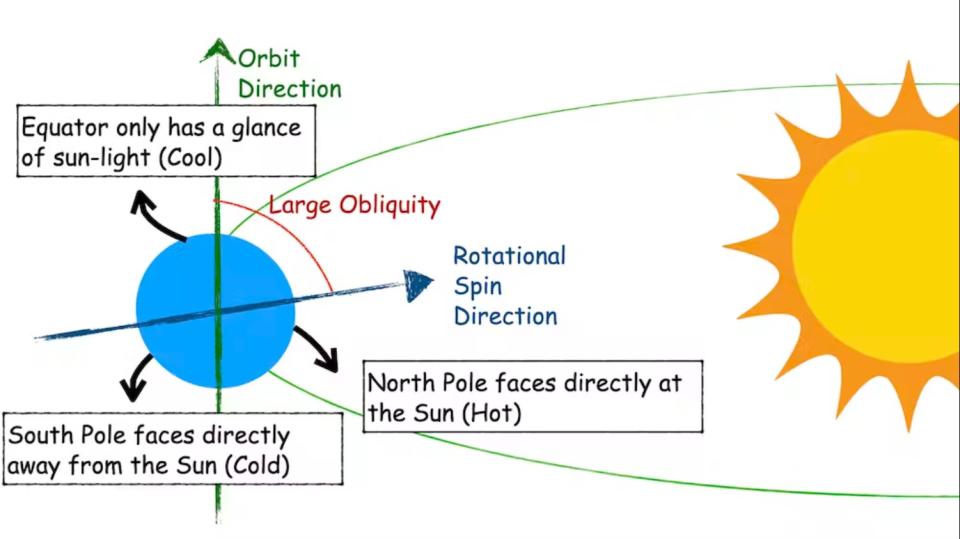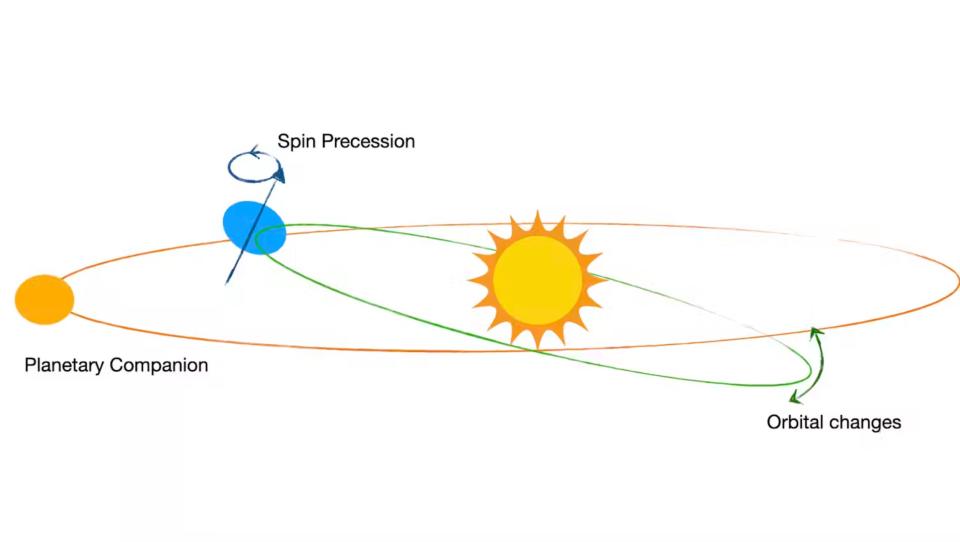Spring, summer, autumn and winter – the seasons on Earth change every few months, around the same time every year. It’s easy to take this cycle for granted here on Earth, but not every planet has a regular seasonal change. So why does Earth have regular seasons while other planets do not?
I am an astrophysicist who studies the movement of planets and the causes of seasons. During my research I discovered that the regular pattern of the seasons on Earth is unique. The axis of rotation around which the Earth revolves, along the North and South Poles, is not completely aligned with the vertical axis perpendicular to the Earth’s orbit around the Sun.
That small tilt has major consequences for everything from seasons to glacier cycles. The magnitude of that tilt can even determine whether a planet is habitable for life.
Related: The scorching alien planet brings the seasons to the extreme
Seasons on Earth
When a planet has perfect alignment between the axis it spins on and the axis of rotation, the amount of sunlight it receives as it orbits the sun is fixed – assuming its orbit shape is a circle. Because seasons arise from variations in the amount of sunlight reaching the planet’s surface, a planet that is perfectly aligned would have no seasons. But the Earth is not perfectly aligned on its axis.
This small deviation, called an obliquity, is about 23 degrees from vertical for the Earth. Thus, the Northern Hemisphere experiences more intense sunlight during the summer, when the sun is more directly above the Northern Hemisphere.
As the Earth continues to revolve around the sun, the amount of sunlight the Northern Hemisphere receives gradually decreases as the Northern Hemisphere tilts away from the Sun. This causes winter.

The planets spinning on their axis and orbiting the sun are a bit like spinning tops: they spin and wobble due to the sun’s gravity. As a top spins, you may notice that it doesn’t just stay perfectly upright and still. Instead, it may tilt or wobble slightly. This tilt is what astrophysicists call spin precession.
Because of these fluctuations, the Earth’s tilt is not perfectly fixed. These small variations in tilt can have major consequences for Earth’s climate, when combined with small changes in the shape of Earth’s orbit.
The wobbly tilt and any natural variations in the shape of Earth’s orbit can change the amount and distribution of sunlight reaching Earth. These small changes contribute to the larger temperature shifts on the planet over thousands to hundreds of thousands of years. This in turn can cause ice ages and periods of warmth.
Translating obligation into seasons
How do variations in tilt affect the seasons on a planet? A low obliquity, meaning the axis of rotation is aligned with the orientation of the planet as it orbits the sun, leads to stronger sunlight at the equator and little sunlight near the pole, as on Earth.
On the other hand, a high obliquity—meaning the planet’s axis of rotation points toward or away from the sun—leads to extremely hot or cold poles. At the same time, the equator becomes cold, because the sun does not shine above the equator all year round. This leads to drastically varying seasons at high latitudes and low temperatures at the equator.


When a planet has an obliquity of more than 54 degrees, that planet’s equator becomes icy and its pole becomes warm. This is called reverse zoning, and it is the opposite of what Earth has.
In short, if a slope has large and unpredictable variations, the seasonal variations on the planet become wild and difficult to predict. A dramatic, large variation in tilt can turn the entire planet into a snowball, completely covered in ice.
Spin orbit resonances
Most planets are not the only planets in their solar system. Their planetary siblings can disrupt each other’s orbits, leading to variations in the shape of their orbits and their orbital tilt.
So planets in orbit look like peaks spinning on the roof of a car bumping along the road, with the car representing the plane of the orbit. When the speed – or frequency, as scientists call it – at which the tips precess or spin matches the frequency at which the car moves up and down, something called spin-orbit resonance occurs.


Spin-orbit resonances can cause these tilt variations, that is, when a planet wobbles on its axis. Think about pushing a child on a swing. If you push at just the right time – or at the resonant frequency – they swing higher and higher.
Mars wobbles more on its axis than Earth, even though the two are tilted about the same amount, and that’s actually due to the fact that the moon revolves around the Earth. Earth and Mars have a similar spin precession frequency, which corresponds to the orbital oscillation – the ingredients for a spin-orbit resonance.
But the Earth has a huge moon, which pulls on the Earth’s axis of rotation and makes it precess faster. This slightly faster precession prevents it from experiencing spin-orbit resonances. So the moon stabilizes the Earth’s obliquity, and Earth doesn’t wobble on its axis as much as Mars does.
Exoplanet seasons
RELATED STORIES:
— NASA’s TESS telescope spots six exoplanets around a ‘misbehaving’ toddler star
– The newly discovered Earth-sized exoplanet has a red-hot lava side
– This alien planet system has a Jovian world that is 99 times larger than Earth
Thousands of exoplanets, or planets outside our solar system, have been discovered in recent decades. My research group wanted to understand how habitable these planets are, and whether these exoplanets also have wild obliquities, or whether they have moons to stabilize them, like Earth.
To investigate this, my group led the first study of the spin-axis variations of exoplanets.
We examined Kepler-186f, the first discovered Earth-sized planet in a habitable zone. The habitable zone is an area around a star where liquid water can exist on the planet’s surface and where life can emerge and thrive.
Unlike Earth, Kepler-186f is far from the other planets in its solar system. As a result, these other planets have only a weak effect on their orbit and motion. So Kepler-186f generally has a fixed inclination angle, similar to that of Earth. Even without a large moon, it doesn’t have wildly changing or unpredictable seasons like Mars.
In the future, more research on exoplanets will help scientists understand what seasons look like across the vast diversity of planets in the universe.